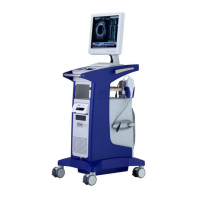Page 140 of 148 300004969171/B
Appendix B: Technology Summary
The development and validation of VH IVUS on the Volcano system platform is outlined
below.
Methods
The human left anterior descending (LAD) coronary artery was obtained at autopsy.
IVUS data from 63 LAD specimens were analyzed with IRB approval from the
Cleveland Clinic Foundation, Cleveland, Ohio. The sample space of the study was
representative of human beings between the ages of 32 and 79 years, having died of
causes not necessarily related to cardiac failure. There were 51 males and 12 females (20
black, 43 white) with a mean age of 55.2 ± 11.6 years. Twenty-three (23) individuals
were diabetic, 40 were not diabetic. The study sample was limited to those without prior
cardiac percutaneous interventions or surgical revascularizations. Additionally, data was
not acquired from alcohol and drug abuse cases. The LAD vessel was harvested, as it
most often contains significant disease and is the site of most acute coronary events.
Human hearts were procured within 24 hours of death, and IVUS data were acquired in
less than 24 hours after excising the LAD vessel. Each artery was dissected from the
ostium to the apex, including approximately 40 mm of surrounding fat and myocardial
tissue. Inclusion of surrounding tissue ensures the maintenance of proper vessel
mechanical support and reduces ultrasound artifacts due to reflections at interfaces. The
vessels were then immersed in phosphate buffered saline (PBS) such that no potential
reflections from the PBS-air interface were present in the ultrasound data.
The harvested arteries were mounted in a paraffin tray. The ostium was cannulated and
side branches were ligated to reduce flow and to maintain physiological perfusion
pressure. Constant flow and pressure was ensured with Volcano’s SmartMap pressure
wire system and a computer-controlled air valve system that pressurized a 20 L PBS tank
to 100 mmHg. The PBS was delivered within a physiological temperature range,
warmed by a heating coil and measured by a thermistor (P/N WM103C, Sensor
Scientific, Fairfield, NJ, USA). This flow system was developed in house, and its usage
has been documented and published.
1
The coronary arteries, were imaged within 24 hours
of collection using Volcano Eagle Eye Gold IVUS transducers with either a standard
Volcano In-Vision Gold imaging system or a Volcano imaging system.

